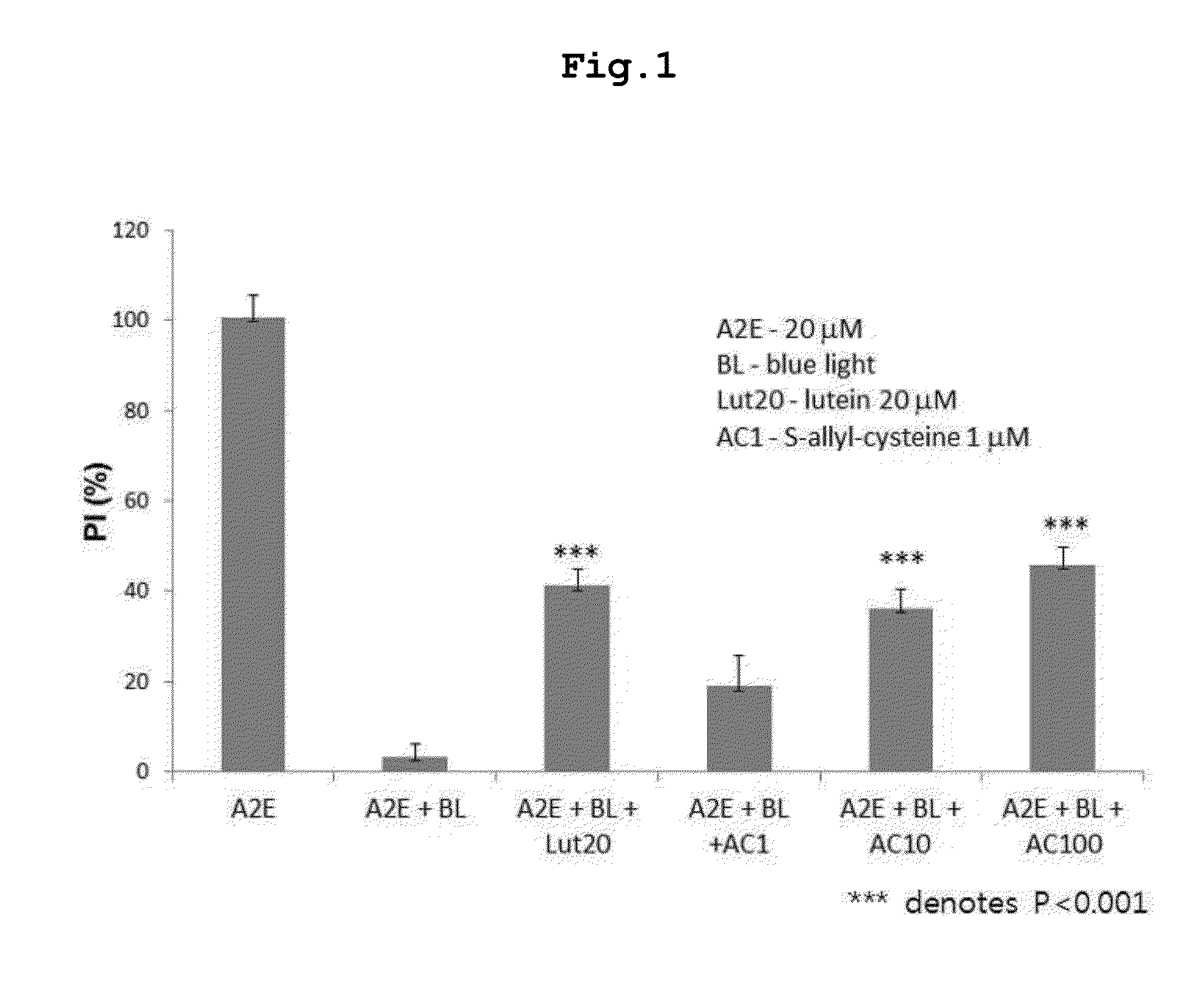Composition for preventing or treating eye diseases, containing s-allyl-l-cysteine as active ingredient, and pharmaceutical formulation containing same
a technology of sallyllcysteine and active ingredient, which is applied in the direction of drug compositions, plant/algae/fungi/lichens ingredients, peptide/protein ingredients, etc., can solve the problems of blindness and visual impairment in older adults, abnormal blood vessel growth under the macula, and vision loss, so as to suppress eliminate the etiology of eye diseases, and inhibit the accumulation of a2e
- Summary
- Abstract
- Description
- Claims
- Application Information
AI Technical Summary
Benefits of technology
Problems solved by technology
Method used
Image
Examples
preparation example
Cell Culture
[0056]The retinal pigment cell line used in experiments and analyses of the present invention arose from a retinal pigment epithelial cell line (ARPE-19: ATCC no. CRL-2302) purchased from the ATCC (American Type Culture Collection, Manassas Va.), and was maintained by passage as described in document (Sparrow, J. R. et al., A2E, alipofuscin fluorophore, in human retinal pigmented epithelial cells in culture. Invest Ophthalmol Vis Sci 1999, 40(12), 2988-95).
[0057]Briefly, the retinal pigment cell line was cultured in Dulbecco's modified Eagle's medium (DMEM, Gibco, USA) supplemented with antibiotics (Gibco, USA) including 100 U / ml penicillin, 100 mg / ml streptomycin, and amphotericin B, and 10% fetal bovine serum (Hyclone, USA) at 37° C. under 5% CO2 conditions. The cells were allowed to adhere to the bottom of the culture plate, and cultured, with passage by treatment with a mixture of 1:4 trypsin: 10% fetal bovine serum (Gibco, USA)-supplemented medium upon confluence.
[0...
experimental example 1
Suppressive Activity of S-Allyl-Cysteine Against Photo-Oxidation
[0059]Assay of S-Allyl-Cysteine for Suppressive Activity Against Blue Light-Induced Oxidation of A2E
[0060]S-Allyl-cysteine was assayed for the ability to suppress the blue light-induced oxidation of A2E. First, 100 μM A2E was diluted to 20 μM in phosphate buffered saline (PBS), and 200 μl of the dilution was placed in each well of 96-well plates. Then, a negative control, a positive control (lutein 20 μM), or predetermined concentrations of S-allyl-cysteine (1, 10, 100 μM) were added to the dilution, and mixed by pipetting.
[0061]An LED lamp emitting blue light with a central wavelength of ca. 430 nm was operated above the microplates to induce photo-oxidation until the A2E absorbance was reduced by half. Absorbance was read on an ELISA before and after the induction of photo-oxidation. The measurements were applied to an A2E standard curve to obtain concentrations of A2E, and the difference in concentration before and a...
experimental example 2
Assay for Inhibitory Activity Against A2E Photo-Oxidation in Human Retinal Pigment Epithelial Cell Line (APRE-19)
[0064]Cytoprotective Activity of S-Allyl-Cysteine Against Blue Light-Induced Apoptosis of A2E-Accumulated Human Retinal Pigment Epithelial Cell Line CARPE-19)
[0065]Human retinal pigment cell line (ARPE-19) was seeded at a density of 5×104 cells / well into 96-well plates, and incubated with 20 μM A2E for 7 days to accumulate A2E. Then, the cells were treated with a negative control, a positive control (lutein: 20 μM), or predetermined concentrations of S-allyl-cysteine (1, 10, 100 μM) before exposure to blue light as described above.
[0066]Thereafter, cell viability was measured using 3-(4,5-dimethylthiazol-2-yl)-2,5-diphenyltetrazoliumbromide (MTT) assay. An MTT assay is a standard colorimetric assay for assessing cell viability, usually in a lab. Generally, viable cells are counted using a hemocytometer, or by measuring optical density; however, this method requires too mu...
PUM
| Property | Measurement | Unit |
|---|---|---|
| total weight | aaaaa | aaaaa |
| oxidative stress | aaaaa | aaaaa |
| antioxidant activity | aaaaa | aaaaa |
Abstract
Description
Claims
Application Information
 Login to View More
Login to View More - R&D
- Intellectual Property
- Life Sciences
- Materials
- Tech Scout
- Unparalleled Data Quality
- Higher Quality Content
- 60% Fewer Hallucinations
Browse by: Latest US Patents, China's latest patents, Technical Efficacy Thesaurus, Application Domain, Technology Topic, Popular Technical Reports.
© 2025 PatSnap. All rights reserved.Legal|Privacy policy|Modern Slavery Act Transparency Statement|Sitemap|About US| Contact US: help@patsnap.com



